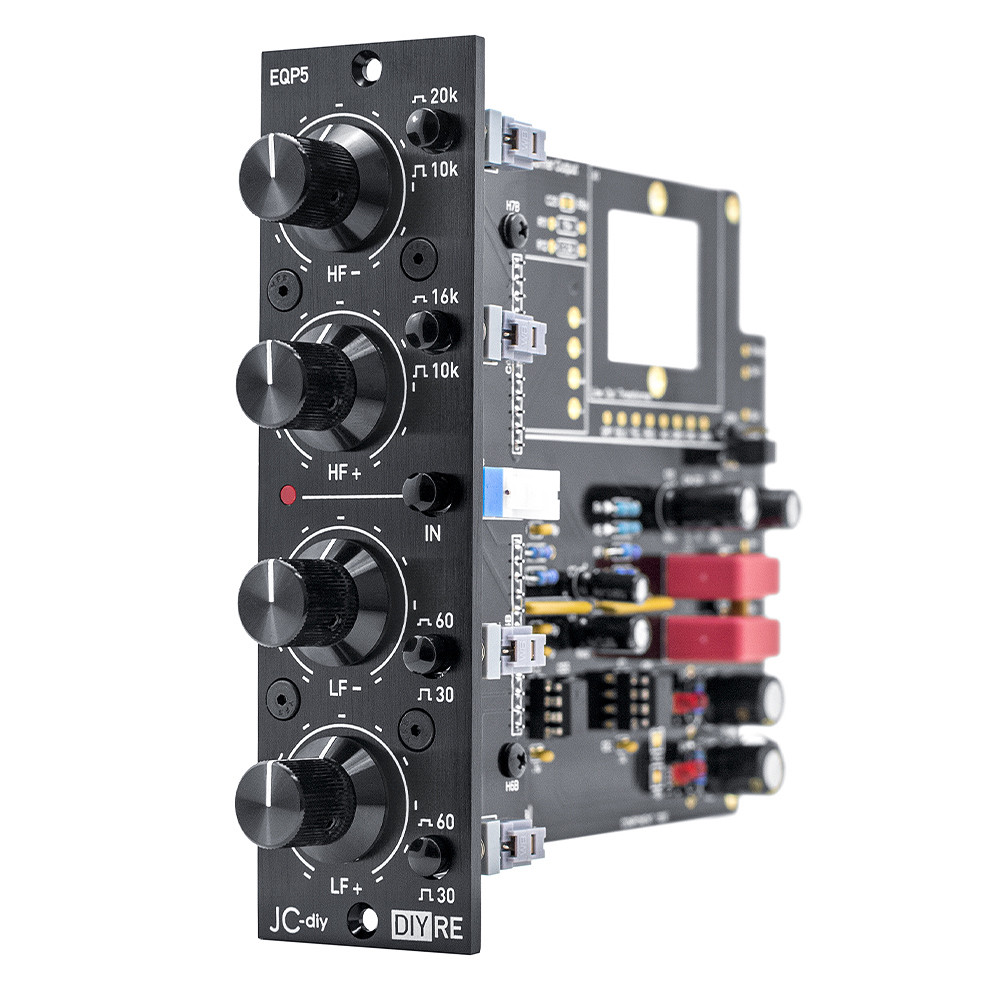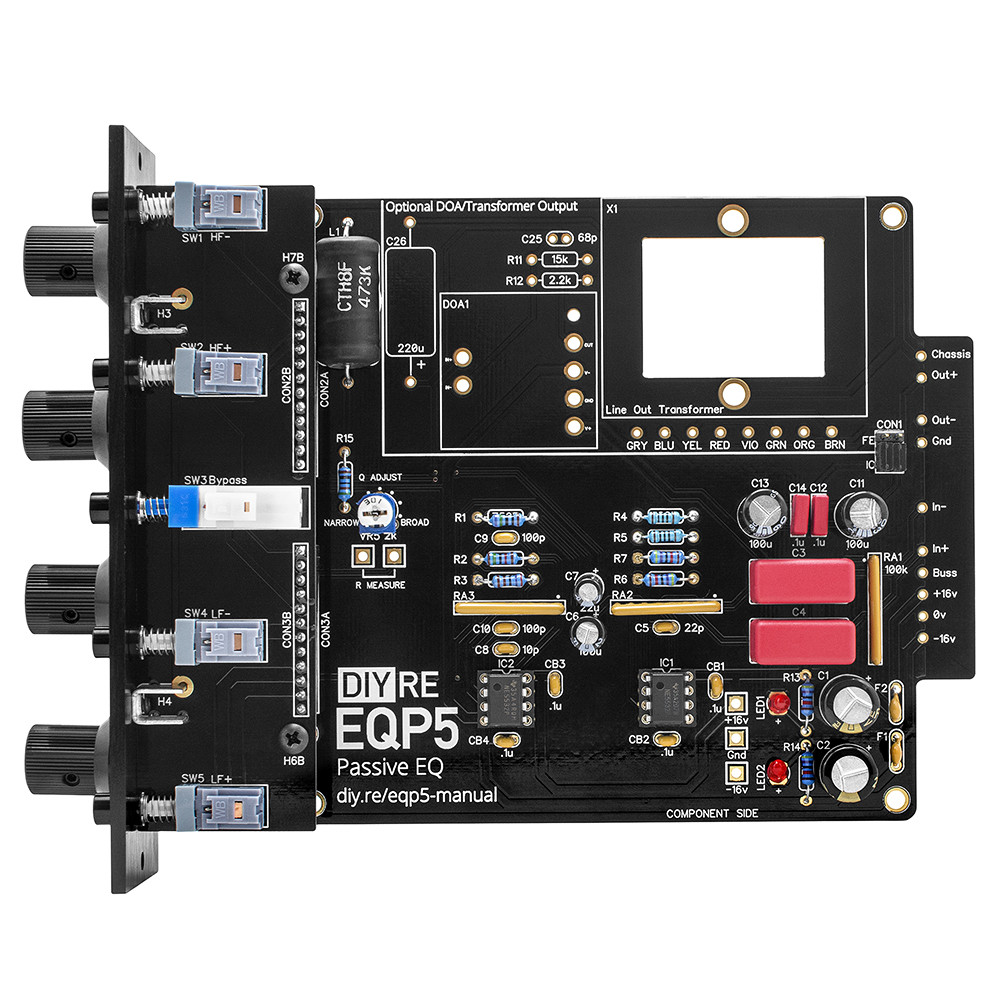New Gear Review: EQP5, a Pultec-Style, 500-Series EQ from DIYRE

With only a set of standard soldering tools and a Phillips-head screwdriver, most DYI enthusiasts can have the DIYRE EQP5 built in about 2 hours or less.
After years of making saturation-based audio gear, Peterson Goodwyn’s DIY Recording Equipment—or DIYRE—has just released their first foray into the world of equalization.
The EQP5 is a collaboration between DIYRE and JC DIY, which is Rascal Audio founder Joel Cameron’s brand.
As the name implies, this EQ is based on the legendary Pultec passive EQ, but designed as a single-space 500-series unit, and made incredibly affordable for those who are interested in soldering together their own gear.
Features and Use
On first inspection, it’s clear that the build quality of the EQP5 meets the high standards DIYRE has set for itself, with an anodized aluminum front panel and stepped knobs, as well as buttons that feel solid and satisfying when pushed.
I’ve sung the praises of DIYRE’s documentation before, and the build instructions found here are as clear and easy-to-follow as ever; I had the unit built in about 2 hours. It’s unlikely that DIY experts or novices would encounter any problems with assembly. Standard soldering tools and a Phillips-head screwdriver are all you need to build the kit, although I strongly recommend buying a decent multimeter for identifying resistors and troubleshooting if necessary.
The design is what one would expect: There are four knobs controlling high and low frequency boost and cut. The frequencies for the bands are switchable for each control: High cut is selectable at 10kHz/20kHz; high boost at 10kHz/16kHz; low cut at 30Hz/60Hz; low boost at 30Hz/60Hz.
The circuit board also allows for further customization of frequencies via extra capacitor and inductor footprints, but for the sake of this review I used the stock options.
At first glance, the choice of frequencies may appear odd, but in use they are very musical. The highs are well-suited for softening overly bright sources, or gently boosting for air or sparkle. Unlike the highs, the low frequency boost/attenuation choices being the same actually creates incredible flexibility. The cuts are great for removing rumble and excessive sub bass, and the boosts are smooth.

DIYRE provides detailed, easy-to-follow assembly instructions for all of their products, and the EQP5 is no exception.
These options are furthered by using a classic passive EQ trick. Boosting and cutting at the same frequency will create resonant peaks a bit higher in the spectrum, adding even more shaping options depending on whether they are set at 30 or 60Hz.
Experiment with different amounts of boost/cut at different settings and this four-knob EQ becomes a much more comprehensive piece of equipment. (You can dig even deeper into the philosophy of the design by checking out designer Joel Cameron’s series of blog posts.)
The stock “Modern” output is designed to provide transparent tone shaping, and the EQP5 excels at that. With knobs at zero there is no coloration, and subtle boosts and cuts are easily done. But that does not mean the EQP5 is only a gentle beast; pushing the low frequency boost reveals a huge bottom. This is a perfect EQ for shaping your drum buss or even a full mix, allowing you to smoothly open the top end or really make the walls rattle with the lows.
The optional “Vintage” output changes the EQP5 from subtle to a more forward, livelier-sounding colored EQ. This is done with the addition of a custom transformer and discrete op-amp (DOA), following the design scheme of the original solid-state Pultecs, which some claim has an even sweeter tone than their tube-based counterparts. You can pick a DOA based on your tastes; DIYRE offers four options: RED-25, BLU-18, GAR1731, and Rogue Five. There are also many more available from third-party retailers like Louder Than Liftoff or Hairball audio.
To Be Critical
There isn’t much to complain about with the EQP5, but it is important to note that it does not have the bandwidth option that many Pultec-style EQs boast. This can be adjusted instead by a trim pot on the circuit board. There are also fewer front panel frequency options than some competitors offer, but adding either of these functionalities would move the unit out of its extremely low price point of $199.
One other notable point is that this is the first 500 Series unit from DIYRE that does not involve their “Colour” saturation system. The vintage option certainly adds character if that’s what you want, but don’t expect to be able to tap into the wide range of DIYRE tonal options with this particular device. Perhaps future EQ designs will incorporate the fantastic Colour system the company is known for.
Summing It Up
Let’s be honest, there is no shortage of Pultec-style EQs on the market, both hardware and software. So what sets DIYRE’s EQP5 apart? There’s the obvious do-it-yourself aspect, which is not only fun and easy but keeps costs down as well. Starting at $199, this kit comes in at a lower price than any other EQ of similar style, and even when adding the “Vintage” output option it is still under $300.
Most importantly, the EQP5 sounds great, and is sneakily a very flexible tool. A passive shelving EQ is a great addition to any engineer’s arsenal, and the EQP5 is a no-brainer for DIY experts and newcomers alike.
Please note: When you buy products through links on this page, we may earn an affiliate commission.






